Cuba, by Land and by LiveaboardContents of this Issue: Cuba, by Land and by Liveaboard Dolphins in Grand Turk Home Swimming Pools? Deep Vein Thrombosis and Decompression Sickness Raja Ampat; The Top Resorts and Liveaboards The Misplaced Optimism of Some Camera Manufacturers California Great White Shark Population on the Rise A Tragically Glamorous Underwater Shoot Why So Many Maui Shark Attacks? Climate Change Wreaks Havoc on Coral Nine Million Dollar Wrongful Death Lawsuit Editorial Office: Ben Davison Publisher and Editor Undercurrent 3020 Bridgeway, Suite 102 Sausalito, CA 94965 two disparate diving worlds from the July, 2016 issue of Undercurrent
Dear Fellow Diver, This month, two of our intrepid undercover writers report on their trips to Cuba, one for resort diving at Maria La Gorda, the other aboard the Jardines Aggressor. Their diving, their accommodations, their food, and the prices they paid couldn't have been more varied and their destinations far apart. Since Cuba is only beginning to open up for American travelers, we'll pay close attention and report again early next year. - Ben Davison Maria La GordaWhen I opened an email offering a combined REEFNeal Watson trip to Havana in early June with 3.5 days of diving in Maria La Gorda, Cuba, I jumped on it, since I have always wanted to see this long-forbidden country. Research taught me not to expect much in the way of infrastructure, food, or organization; however, the long waits, low quality hotels and food, and a profoundly disorganized dive operation set me back on my heels.
The Havana hotel, Quinta Avenida Hotel Habana, is rated five stars in Cuban terms and maybe worth 2.5 in world terms. One night, the air conditioning did not work; the large, spare rooms have tile floors and minimal bedding. Breakfast was excellent, however, a buffet that never ended. Expect improvements: soon the hotel will be managed and renovated by Marriott/Starwood. On day two, we boarded a Chinese-built motor coach for the 5.5-hour ride to the southwest hamlet of Maria La Gorda, where the Villa Maria La Gorda houses a dive operation. The roads were rough, the countryside lush and green, and the route wound through the famed tobacco-growing region, Pinar Del Rio. The trip was not helped by the last lashings of Tropical Storm Colin, which dampened our first couple of days.
But what of the diving? The resort was overwhelmed by divers, many from Mexico, who came for a photography contest. The shop had promised a boat just for our group, but instead we were crammed in with another 20 divers, so most trips had 36-40 divers. Our guide, whose name was Abbot (very un-Cuban!), was excellent, but he could do nothing about the crowding. Perhaps owing to the number of divers, the dive schedule constantly changed. Our checkout dive at Yemayá, a nearby site with swim-thrus and nice sponges, left at 5:40 P.M. It was pouring rain and the viz was low. I noticed how much reef-building halameda algae abounded at this,and at most other sites, although I also noticed considerable hurricane damage and algal growth.
Meals were crowded as well. The buffet included a wide variety of food, but common sense dictated avoiding salads and raw veggies. Ingredients were generally low quality, particularly meats, though the dessert table groaned. Our guide told us that diabetes is common in Cuba, and maybe the dessert table offers a clue why. I found the food bland, excepting the ropa vieja, a slow-cooked spiced chopped meat. You could get eggs cooked to order at breakfast, although the very hot grill tended to burn them. I got enough food -- supplemented it with power bars I brought from home -- but can't say I enjoyed it. The prettiest dive was Paraiso Perdido, aptly named Lost Paradise. There was some current, but the upside was schools of grunts and snappers, and a surprising density of three species of chubs. Cero and mackerel streaked between schools of boga and Creole wrasse, all set off by a lush drop-off festooned with deep-water gorgonians and sponges. Another dive at Cuevas de Pedro offered a scenic series of swim-thrus, starting at 50 feet and ending around 80 feet. My buddy watched a three-spot damsel hide from a lionfish, which made me wonder whether the reef fish were at last learning about these predators. On a drift dive between El Jardin de las Gorgonias and El Patio de Vanesa, I saw two seriously big greater amberjacks muscle their way over the patch reef. Wow. Particularly on the deep sites (which were in better shape), I could have enjoyed far more bottom time had Nitrox been available, but air was the only option.
Between the lionfish and the leaching of untreated sewage, one must wonder how long the Cuban reefs have before they are overgrown with algae. According to reports I read from The International Coral Reef Initiative (www.icriforum.org) and NOAA's Coral Reef Conservation program (http://coralreef.noaa.gov), Cuba's reefs are affected by the bleaching event of 2015, runoff from fertilizer and sewage, storm damage, overfishing, and particulate pollution. The shoreline around Havana is particularly foul, thanks to two rivers, laden with untreated sewage and garbage, emptying into Havana Harbor. However, some areas, particularly on the south side of the island, are protected by long, shallow plateaus that take the brunt of the land-based damage before dropping off in what everyone in the REEF group agreed were healthier deep reefs. For whatever future foreign development may come, the government should stipulate that they must incorporate new, non-polluting, enclosed state-of-the-art sewage systems. This would mitigate some effects of increased tourism, and though it would not address agricultural runoff and particulate pollution, it would at least keep new developments from adding to sewage pollution.
I've been pondering my trip. On one hand, despite its discomforts and poverty, it is a lush island, and there is a thrill to going there as an American. The classic cars are for real and provoked aficionados to call out sightings like "'54 Plymouth" or "'57 Biscayne." On the other hand, it is a lot of trouble, not that cheap, involves long waits, mediocre food, rough travel, and where I visited, average diving. I am glad I've checked it off my bucket list, but next time I head to that part of the Caribbean for land diving, I'll go to Cozumel and the Yucatan. Or perhaps, consider a Cuban liveaboard, as another Undercurrent reporter, traveling just a month before me, had a better trip. -- A.E.L Our author, a longtime supporter of REEF, and has dived all over the world, making about 150 dives per year, divided between the Caribbean and the Indo-Pacific. Previously, A.E.L. wrote about the Caribbean Explorer II.
MV Jardines AggressorDear Fellow Diver, It hit me at Five Seas, the second dive of the second day, in the Gardens of the Queen (Jardines De La Reina). I felt elation and profound sadness at the same time. The reefs here were like the Florida Keys and Bahamas were 45-50 years ago. All the little guys -- wrasses, chromis, royal grammas, damselfish, and assorted butterflies were abundant. And the intermediates -- grunts, schoolmasters, snappers, and jacks -- thrived along with the bigger guys -- Nassau, black and Goliath groupers, tarpon, permits, and reef sharks. The soft and hard corals were cheek-to- cheek-to-jowl in places. The whole gang was here and healthy, the very definition of pristine. What have we done to the rest of the Caribbean in two generations?
It was the first time the refitted former Cayman Aggressor was cruising with a full manifest of 20 guests (18 Americans and two Aussies.) There are two master cabins forward of the main salon on the dive deck and eight cabins below. Our master had a king platform bed with lots of stowage beneath. It occupied most of the cabin, so we had to squeeze around the edge to get out the door or into the small bathroom with a stall shower. After having to clear the plumbing system three times the first day, we were told to keep the marine heads like modern record-keeping -- paperless. The Gardens of the Queen is a string of islands 52 miles off Cuba's southcentral coast, forming the southern edge of the Bay of Ana Maria. The bay averages 60 feet in depth, with extensive seagrass beds making a huge marine nursery. The reef wall, which is anywhere from 100 to 300 yards from the islands' shorelines, begins at 15 to 25 feet and drops to a sandy bottom at 65 to 100 feet. Visibility didn't exceed 90 feet and in one case got down to 25. At Gruta Del Tarpon (Tarpon Grotto), I swam down through a 20-foot opening into a passage five feet high and emerged to be greeted by schools of three-foot tarpon. As on most dives, several Caribbean sharks cruised at discreet distances. A cleaner fish patrolled the head of a green moray, young hogfish lined up at brain coral like a cleaning station, and I saw something I'd never observed before: a formation of six trunkfish.
Hardcore divers might be disappointed because there are only four dives per day -- 8A.M., 11A.M., 3P.M., and an 8 P.M. night dive, which was never well-attended. (One night dive was canceled due to bad weather). The night dive at Cuevo Del Pulpo (octopus cave) began along the wall with little red shrimp, banded coral shrimp, a hogfish, and a large spider crab. When a bloodworm (a nuisance in places at night) touched an outstretched tentacle of a basket star unfurling in the current, the tentacle quickly coiled around the worm, pulling it toward the star's center mouth, where other tentacles assisted. The worm disappeared. I checked out a section of a cave mouth that looked like it was adorned with cross-sectioned kiwi fruits but seemed to be an anemone colony. When capturing prey, the rims extended outward then closed toward the center, somewhat resembling a diaphanous brown tulip. An obliging octopus, its body the size of a grapefruit, flashed through several color changes, giving the underwater photographers good video footage. For the photogs, the dive deck had a spacious three-level camera table with a compressed air hose. Enough to keep the two professionals (Jim Van Gogh of Monterey, CA, and Glen Cowans, an Aussie), as well as the amateurs, happy. Almost everyone used the outlets in the main salon to charge their power supplies. The experienced dive guides -- two accompanied each dive -- have worked for the Avalon group that holds the Jardines Aggressor franchise, but still, a few mistakes were made. On one dive, the guide led the group along the wall with the current. Not the way I learned it. I turned my buddy around, and we tooled back toward the mooring and had a great dive puttering around. The other guide, Noel, came back to keep an eye on us. The group eventually returned, grousing later about having to do hard work into the current at the end of the dive. Typically after a dive, the 10 divers were easy to count informally, since we line up five on each side of the boat. However, at the end of one dive, while waiting for our guide to come up, someone asked, "Where's Bob?" (one of the 70-year-old divers). It turned out that underwater he had asked our guide, Noel, where the tender was, and was pointed in the general direction. Bob and his buddy had both been doing photography, and, as is often the case in that situation, they were buddies only in the sense that they were in the same ocean. Without enough Nitrox or power to get back, he was spotted floating 100 yards away with a failed safety sausage. In calm water, he wasn't in much distress, but was glad to be picked up. (By the way, he has a nice 13-minute video of the trip at bobthediver on YouTube -- Click on his picture to choose the video.)
The dining room was above the main deck. It had a small bar aft of the forward bulkhead and four tables that each sat five guests. It was a gregarious group, so there was no established seating pattern. Outside was a covered afterdeck, gas grill, and the prerequisite Aggressor jacuzzi. Above the dining deck, there was a shadeless sundeck with a great view. Cruise Director/Bartender Yoel makes a mean mojito. Beer choices were Cuban-brewed Bucanero Fuerte (strong) or Cristal (lighter.) Tell your friends you spent a week swigging Cristal and eating lobster and they'll know you were living large. After night dives, hot chocolate was served with or without a splash of Santiago de Cuba rum. To get near a Wi-Fi hotspot one day, we took an exhilarating boat ride through the mangroves to the Avalon base where the Tortuga Barge Hotel was moored. We weren't invited aboard, but we did connect with their Wi-Fi to send messages home. Another day, we visited an island to feed iguanas and hutias, a rodent reminiscent of a beaver without the big tail. Twice after the 3 P.M. dive, we boated to the mangroves to snorkel with saltwater crocs. Cooperative subjects, they allowed some decent close-ups. I heeded the advice to keep my camera between the crocs and me, though I wasn't sure how my little GoPro would dissuade a six-foot crocodile from doing a taste test. There was also an afternoon predive drift snorkel on the incoming tide between the islands, where the shallows were strewn with conchs and starfish. On the last morning, we dove El Farallon (The Cliff), the goal being to dive with silky sharks. The guide led us through two 90-foot-deep cuts in the reef, wending through the narrow canyons, where just a bit of light filtered down from the surface. A nice hawksbill was outside the second pass, though. Our guide mistimed our return to the boat, leaving little time for observing the sharks, and the big breathers only had time for a safety stop before surfacing. I didn't mind, since I don't like organized shark dives; they teach sharks aberrant behaviors. And I didn't like their strategy. They lowered a chum box on a line from the tender, bringing silky sharks under the boat. Then, when all divers were on board, they pulled in the box and threw carcasses to the silkies next to the boarding ladders. Entertaining to watch, but maybe not such a good idea when future divers climb up the ladder and the white bottoms of their feet get mistaken for bait. To get to the Havana airport for afternoon flights, we departed from the boat at 4 A.M. As a third world insurance policy, an empty bus trailed the passenger bus in case of breakdown. Jardines De La Reina is a huge marine preserve, an underwater Garden of Eden. Where else would I see more than a hundred young tarpon streaming by? Or see a spur jutting out from the reef that looks like a moving yellow wall because the whole projection is covered with a massive collection of porkfish, schoolmasters, and grunts? Clearly, the reviewer in our first article missed the best of Cuba, though I paid about three times as much to see it. - J.A.S. About the author: I've been diving more than 50 years, having learned at age 12 from Mike Kevorkian, whose name is on the base of the Christ of the Abyss in the Florida Keys, long before certification was required. I've seen the Florida Keys and Bahamas before they were spoiled, dived throughout the Caribbean, as well as Cocos, Galapagos, and Palau. In my youth, I had the good fortune to meet Captain Jacques Cousteau and board the Calypso to advise the crew about where to look for blue holes in the Bahamas. How many high school kids get to meet their heroes?
|

I want to get all the stories! Tell me how I can become an Undercurrent Online Member and get online access to all the articles of Undercurrent as well as thousands of first hand reports on dive operations world-wide
| Home | Online Members Area | My Account |
Login
|
Join
|
| Travel Index |
Dive Resort & Liveaboard Reviews
|
Featured Reports
|
Recent
Issues
|
Back Issues
|
|
Dive Gear
Index
|
Health/Safety Index
|
Environment & Misc.
Index
|
Seasonal Planner
|
Blogs
|
Free Articles
|
Book Picks
|
News
|
|
Special Offers
|
RSS
|
FAQ
|
About Us
|
Contact Us
|
Links
|
3020 Bridgeway, Ste 102, Sausalito, Ca 94965
All rights reserved.

 My buddy and I were required to arrive four hours in advance of
our Eastern Airlines flight (yes, that one, a charter airline who bought
the logo and name), then wait in the shabby
old F terminal in Miami. Bring patience, and
maybe extra pillows. But, bring more than 44
pounds of luggage, including carry-ons, and
you're slapped with a $2/pound surcharge. My
buddy and I, never light packers, paid $296
extra, mostly for two bags of scuba gear. Too
much later, I did the arithmetic and realized
we had been overcharged by more than twice.
My buddy and I were required to arrive four hours in advance of
our Eastern Airlines flight (yes, that one, a charter airline who bought
the logo and name), then wait in the shabby
old F terminal in Miami. Bring patience, and
maybe extra pillows. But, bring more than 44
pounds of luggage, including carry-ons, and
you're slapped with a $2/pound surcharge. My
buddy and I, never light packers, paid $296
extra, mostly for two bags of scuba gear. Too
much later, I did the arithmetic and realized
we had been overcharged by more than twice.  Once at the hotel, we dragged our bags down dirty paths and up three flights
of stairs to our mildew-smelling small room in one of the "new" buildings. The walls were spotted with dead insects, two lighting fixtures hung by wires, and the TV and fridge did not work. Housekeepers had folded towels in fanciful shapes, but
the bedside rugs were dirty. Since almost all flooring is tile (including around
the dive shop), it was slick when wet. My buddy and both I endured some nasty
falls, and, as I type this, my right elbow is still swollen and sore.
Once at the hotel, we dragged our bags down dirty paths and up three flights
of stairs to our mildew-smelling small room in one of the "new" buildings. The walls were spotted with dead insects, two lighting fixtures hung by wires, and the TV and fridge did not work. Housekeepers had folded towels in fanciful shapes, but
the bedside rugs were dirty. Since almost all flooring is tile (including around
the dive shop), it was slick when wet. My buddy and both I endured some nasty
falls, and, as I type this, my right elbow is still swollen and sore.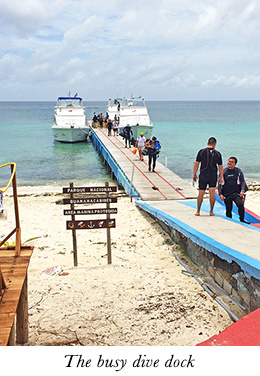 On day two, our 8 A.M. dive finally left at 10:40. I had to skip this dive thanks to slipping
down a flight of wet stairs, but was OK for the
afternoon dive at Cabeza de Ludo. It featured high
profile coral bommies and swim-thrus; the second
afternoon dive, at Cabeza de Marcelo, was the
most enjoyable of the day, partly because fewer
divers crammed the boat.
On day two, our 8 A.M. dive finally left at 10:40. I had to skip this dive thanks to slipping
down a flight of wet stairs, but was OK for the
afternoon dive at Cabeza de Ludo. It featured high
profile coral bommies and swim-thrus; the second
afternoon dive, at Cabeza de Marcelo, was the
most enjoyable of the day, partly because fewer
divers crammed the boat.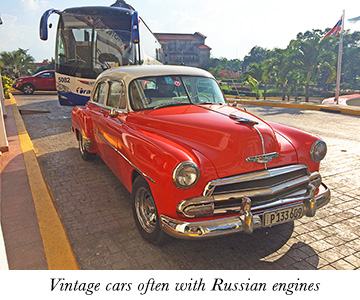 Diving with Reef Environmental and Educational Fund fish surveyors means
joining some keen and informed eyes. Our first day, the group identified 144 species.
By the end of 3.5 dive days, the count came to about 180, with a few fish
yet to be identified; because lionfish aren't culled, they were seen on every
dive. (In the region that includes Cuba, 445 species have been recorded in Roatan, with 418 species recorded in Cozumel, but both have had far more surveyors.)
Diving with Reef Environmental and Educational Fund fish surveyors means
joining some keen and informed eyes. Our first day, the group identified 144 species.
By the end of 3.5 dive days, the count came to about 180, with a few fish
yet to be identified; because lionfish aren't culled, they were seen on every
dive. (In the region that includes Cuba, 445 species have been recorded in Roatan, with 418 species recorded in Cozumel, but both have had far more surveyors.)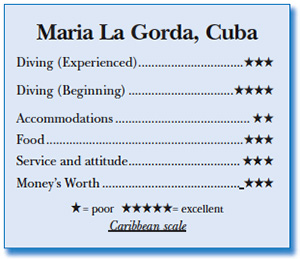 After another a bus ride back to Havana, with a stop at a tobacco plantation
(cigar lovers rejoiced!), we arrived at the Quinta Avenida Hotel for a night on
the town, which included a floor show at the Hotel Naçional, offering a modestly clad, Vegas-style musical version of Cuban history, all in Spanish.
You can forget visiting the national aquarium, where the sea turtles are crammed into tiny bare tanks and the fish tanks dirty and missing animals.
After another a bus ride back to Havana, with a stop at a tobacco plantation
(cigar lovers rejoiced!), we arrived at the Quinta Avenida Hotel for a night on
the town, which included a floor show at the Hotel Naçional, offering a modestly clad, Vegas-style musical version of Cuban history, all in Spanish.
You can forget visiting the national aquarium, where the sea turtles are crammed into tiny bare tanks and the fish tanks dirty and missing animals.  Diver's Compass: the cost, including airfare from Miami, was just
under $2000/person, including most meals, five dives, and transfers;
for other meals, dives, and drinks, I spent $400. . . .
Extra dives at Maria La Gorda cost $22.60. The rainy/hurricane
season runs from June-September, and when it's wet, it's unpleasant.
. . . Water temps were around 80F in June. . . . There is no
shore diving. . . . the dive shop has some rental gear, but not a
lot. . . .A beer was included at most buffet meals at Maria La
Gorda, and I particularly liked Bucanero, a hearty brew. You can
bring in duty-free booze, but be sure to try the local mojitos. You can return
with a box of cigars and bottles of harsh Cuban rum. . . .We left for the Havana airport five hours ahead of the flight's actual departure. Cuban time is like Indonesian rubber time. . . . Bring antibacterial wipes, since most bathrooms have no soap or toilet paper. . . . Tap water is not potable. I carried a lightweight Sawyer camper's filter that attaches to a squeeze bag to make safe water for brushing teeth and drinking; bottled water runs $1.50 to $2.50. . . . I brought microfiber towels from Costco and little pillows, and left them behind.
Diver's Compass: the cost, including airfare from Miami, was just
under $2000/person, including most meals, five dives, and transfers;
for other meals, dives, and drinks, I spent $400. . . .
Extra dives at Maria La Gorda cost $22.60. The rainy/hurricane
season runs from June-September, and when it's wet, it's unpleasant.
. . . Water temps were around 80F in June. . . . There is no
shore diving. . . . the dive shop has some rental gear, but not a
lot. . . .A beer was included at most buffet meals at Maria La
Gorda, and I particularly liked Bucanero, a hearty brew. You can
bring in duty-free booze, but be sure to try the local mojitos. You can return
with a box of cigars and bottles of harsh Cuban rum. . . .We left for the Havana airport five hours ahead of the flight's actual departure. Cuban time is like Indonesian rubber time. . . . Bring antibacterial wipes, since most bathrooms have no soap or toilet paper. . . . Tap water is not potable. I carried a lightweight Sawyer camper's filter that attaches to a squeeze bag to make safe water for brushing teeth and drinking; bottled water runs $1.50 to $2.50. . . . I brought microfiber towels from Costco and little pillows, and left them behind. 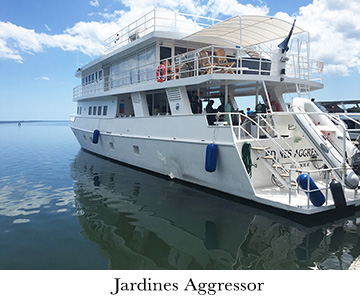 My buddy and I arrived in April
on an ABC charter flight from Miami,
under the auspices of the Oceans for
Youth Foundation, a program requiring
several informative meetings with Cuban
marine biologists. The package included
two nights at the luxury Iberostar Park
Central Hotel, all meals in Havana, and
a day touring the city, followed by an
8:00 A.M. departure on the tour bus for
the 280-mile, six-hour trip to the town
of Jucaro where the Jardines Aggressor
was docked.
My buddy and I arrived in April
on an ABC charter flight from Miami,
under the auspices of the Oceans for
Youth Foundation, a program requiring
several informative meetings with Cuban
marine biologists. The package included
two nights at the luxury Iberostar Park
Central Hotel, all meals in Havana, and
a day touring the city, followed by an
8:00 A.M. departure on the tour bus for
the 280-mile, six-hour trip to the town
of Jucaro where the Jardines Aggressor
was docked. We dived from 28-foot tenders, with
bench seating and a rail down the center
with BC/tank set-ups bungeed to each side.
The boats had narrow beams, so it got crowded
gearing up, and with weight integrated
BCs dropped in tight spaces, my buddy and
I both had minor damage to our regulators.
After crewmembers had lifted BC/tank combos
from the water, divers climbed the sturdy
ladders (which needed another step and an
adjustment to prevent angling under the boat
as a diver ascended).
We dived from 28-foot tenders, with
bench seating and a rail down the center
with BC/tank set-ups bungeed to each side.
The boats had narrow beams, so it got crowded
gearing up, and with weight integrated
BCs dropped in tight spaces, my buddy and
I both had minor damage to our regulators.
After crewmembers had lifted BC/tank combos
from the water, divers climbed the sturdy
ladders (which needed another step and an
adjustment to prevent angling under the boat
as a diver ascended).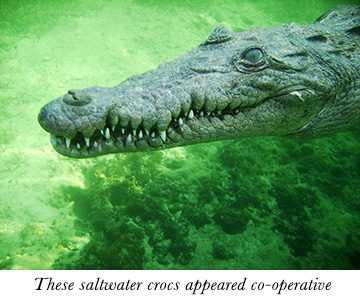 Including Tony, the biologist,
there was a staff of 14, enthusiastic
and eager to show us a good time.
Fabio, the Italian head chef, included a pasta course in most dinners, and, except
for steak night, where the beef was so tender you could cut it with a chainsaw,
the meals were quite good. Fresh tropical fruits -- mango, papaya, and pineapple
-- were served at breakfasts and lunch. At least four meals included local lobster.
Though there was no lettuce, there was kale, cabbage chiffonade, and a type
of spinach for salads. Veggies included sweet and regular potatoes, carrots, and
cauliflower. (The one vegan seemed quite satisfied with her choices.) After the
guides shot several lionfish for shark chum, I asked if the chef could turn some
into ceviche. It was tasty.
Including Tony, the biologist,
there was a staff of 14, enthusiastic
and eager to show us a good time.
Fabio, the Italian head chef, included a pasta course in most dinners, and, except
for steak night, where the beef was so tender you could cut it with a chainsaw,
the meals were quite good. Fresh tropical fruits -- mango, papaya, and pineapple
-- were served at breakfasts and lunch. At least four meals included local lobster.
Though there was no lettuce, there was kale, cabbage chiffonade, and a type
of spinach for salads. Veggies included sweet and regular potatoes, carrots, and
cauliflower. (The one vegan seemed quite satisfied with her choices.) After the
guides shot several lionfish for shark chum, I asked if the chef could turn some
into ceviche. It was tasty.